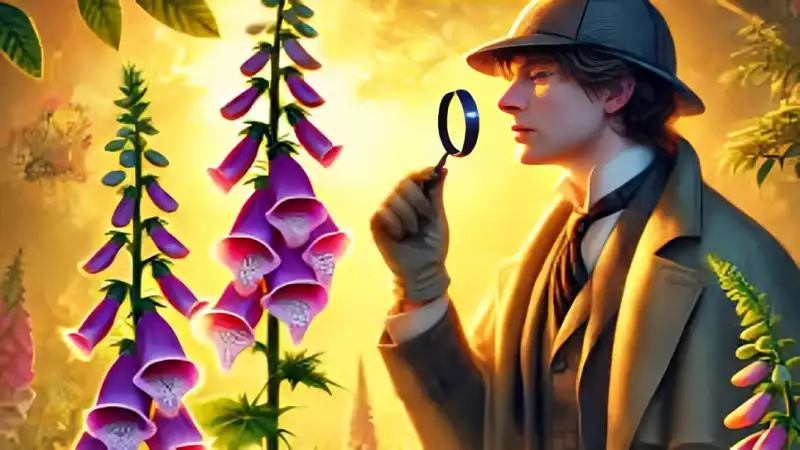The phrase “Gumshoe Foxglove” combines the intrigue of mystery and the complexity of nature. “Gumshoe” refers to detectives, those skilled at uncovering hidden truths. “Foxglove,” on the other hand, is a captivating but toxic plant, a symbol of beauty with a hidden danger. Together, they create an image of solving mysteries while appreciating the intricate balance of nature.
This article dives deep into the origins, symbolism, and relevance of these terms. It also explores their impact on storytelling, everyday life, and creative endeavors.
The Origins of the Term “Gumshoe”
The term “gumshoe” emerged in the late 19th and early 20th centuries. It originally described the soft-soled shoes worn by private investigators. These shoes allowed detectives to move silently, following suspects without being noticed. Over time, the word became synonymous with the detectives themselves.
Detectives, or gumshoes, are characterized by their relentless pursuit of truth. They rely on observation, intuition, and logical reasoning. Figures like Sherlock Holmes and Hercule Poirot have brought gumshoes into popular culture, making them icons of curiosity and intellect.
Foxglove: The Duality of Beauty and Danger

Foxglove, or Digitalis purpurea, is a striking plant known for its bell-shaped flowers. These flowers bloom in vibrant shades of pink, purple, and white. Despite its beauty, foxglove is highly toxic. Consuming any part of the plant can lead to severe poisoning or even death.
Interestingly, foxglove contains digitalis, a compound used in heart medications. This dual nature—harmful and helpful—makes the plant a fascinating subject. It symbolizes the complexity of nature, where beauty often hides danger.
The Connection Between Gumshoe and Foxglove
The combination of “gumshoe” and “foxglove” creates a metaphor for life’s mysteries. Detectives uncover hidden truths, much like exploring the secrets of nature. Foxglove, with its dual nature, reflects the complexity of situations that gumshoes often encounter.
This connection symbolizes themes of curiosity, caution, and discovery. It reminds us that the pursuit of truth requires understanding both the obvious and the hidden.
Gumshoe Foxglove in Literature
In literature, gumshoes and foxgloves often appear as symbols. Detectives in novels are portrayed as clever and resourceful. Similarly, foxgloves are described as enigmatic plants, adding layers to the story.
For example, in Agatha Christie’s mysteries, gardens and plants often play a role in solving crimes. A foxglove plant might serve as a clue or a metaphor for deception. Combining these elements creates engaging narratives filled with suspense and beauty.
Life Lessons from Gumshoe Foxglove
The concept of Gumshoe Foxglove offers valuable lessons:
- Embrace curiosity. Detectives succeed because they ask questions and explore. Life, too, requires curiosity to uncover opportunities and solve problems.
- Respect complexity. Foxglove teaches us that appearances can be deceiving. It’s a reminder to consider all aspects of a situation before making decisions.
- Solve challenges step by step. Gumshoes tackle cases methodically. Similarly, breaking down life’s challenges into smaller steps makes them manageable.
Modern Depictions of Gumshoe Foxglove
Modern media continues to explore the themes of Gumshoe Foxglove. TV shows like Sherlock, Broadchurch, and True Detective highlight the gumshoe’s role in unraveling mysteries. These stories often include natural elements that play a symbolic role.
Foxglove, as a plant, is frequently featured in documentaries and educational programs. Its beauty and danger captivate viewers, showcasing the delicate balance of ecosystems.
The Symbolism of Gumshoe Foxglove in Art
Artists and creators use Gumshoe Foxglove as inspiration for various projects.
- Visual Art. Paintings might depict a detective surrounded by foxgloves, symbolizing the pursuit of truth amidst hidden dangers.
- Poetry. Poets often use foxglove to explore themes of deception, beauty, and mortality.
- Film and Literature. Storytellers create narratives where mystery and nature intertwine, using foxglove as a pivotal element.
Practical Applications of Gumshoe Foxglove in Everyday Life

The idea of Gumshoe Foxglove isn’t limited to fiction or art. It can influence how we approach challenges in real life:
- Detective-like Thinking. Develop skills like observation and critical analysis. These are useful in problem-solving and decision-making.
- Appreciation of Nature. Recognize the complexities of the natural world. Learn to see the hidden connections in ecosystems.
- Balancing Curiosity and Caution. Be curious, but also cautious when exploring unknown territories, whether in relationships, work, or nature.
Creative Ways to Explore Gumshoe Foxglove
For writers, artists, and hobbyists, Gumshoe Foxglove offers endless possibilities:
- Write a Novel. Create a detective story where the central clue is a foxglove plant.
- Design an Art Piece. Illustrate a scene blending detective imagery with blooming foxgloves.
- Develop a Game. Imagine a mystery game where players solve puzzles involving plants and nature.
These creative endeavors highlight the versatility and intrigue of the concept.
Why Gumshoe Foxglove Captures Our Imagination
Gumshoe Foxglove combines two powerful ideas: the pursuit of truth and the complexity of nature. It appeals to our innate curiosity and love for mystery. Whether in storytelling, art, or everyday life, it inspires us to look deeper and question the world around us.
Conclusion
Gumshoe Foxglove is a fascinating concept that merges mystery and nature. It symbolizes the pursuit of truth and the recognition of hidden dangers. Whether through literature, art, or daily life, it inspires us to observe, question, and appreciate the complexities around us.
By embracing the lessons of Gumshoe Foxglove, we can uncover life’s mysteries with curiosity and wisdom.
FAQs
1. What is the significance of the term “gumshoe”?
“Gumshoe” refers to detectives, named for the soft-soled shoes that allowed them to move quietly. It symbolizes persistence, observation, and uncovering hidden truths.
2. Why is foxglove considered dangerous?
Foxglove is toxic due to a compound called digitalis. While it’s used in heart medications, improper consumption can be fatal. Its beauty often hides its danger.
3. How are gumshoe and foxglove connected?
Both represent hidden complexities. Detectives uncover truths, while foxglove symbolizes beauty with a hidden danger. Together, they highlight the need for curiosity and caution.
4. How is foxglove used in literature?
Foxglove often appears as a symbol of deception or duality. In mysteries, it might serve as a clue or metaphor, enriching the narrative.
5. Can the concept of Gumshoe Foxglove be applied to daily life?
Yes. It teaches us to be observant, respect complexity, and tackle challenges methodically. These lessons are valuable in personal and professional settings.
6. What creative projects can be inspired by Gumshoe Foxglove?
You can write a detective story, create art blending mystery and nature, or design a game with puzzles involving plants like foxglove. Read More Famelifestyle.